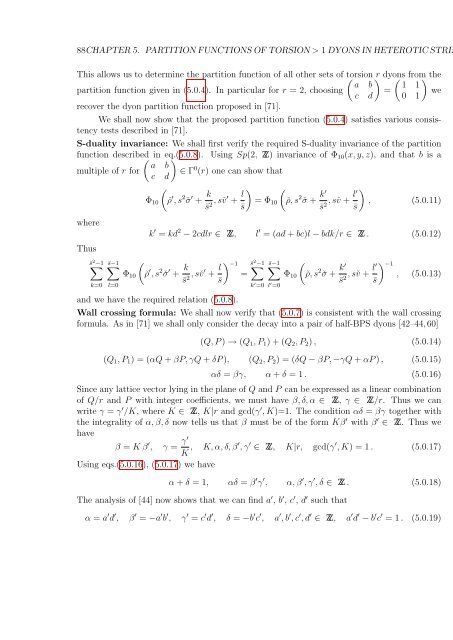PHYS08200604018 Shamik Banerjee - Homi Bhabha National ...
PHYS08200604018 Shamik Banerjee - Homi Bhabha National ...
PHYS08200604018 Shamik Banerjee - Homi Bhabha National ...
Create successful ePaper yourself
Turn your PDF publications into a flip-book with our unique Google optimized e-Paper software.
88CHAPTER 5. PARTITION FUNCTIONS OF TORSION > 1 DYONS IN HETEROTIC STRIN<br />
This allows us to determine the partition function of all other sets of ( torsion ) r dyons ( from)<br />
the<br />
a b 1 1<br />
partition function given in (5.0.4). In particular for r = 2, choosing = we<br />
c d 0 1<br />
recover the dyon partition function proposed in [71].<br />
We shall now show that the proposed partition function (5.0.4) satisfies various consistency<br />
tests described in [71].<br />
S-duality invariance: We shall first verify the required S-duality invariance of the partition<br />
function described ( in eq.(5.0.8). ) Using Sp(2, Z) invariance of Φ 10 (x, y, z), and that b is a<br />
a b<br />
multiple of r for ∈ Γ<br />
c d<br />
0 (r) one can show that<br />
(<br />
Φ 10 ˇρ ′ , s 2ˇσ ′ + k¯s , 2 sˇv′ + l¯s<br />
)<br />
= Φ 10<br />
(ˇρ, s 2ˇσ )<br />
+ k′<br />
, sˇv + , (5.0.11)<br />
¯s<br />
2<br />
l′¯s<br />
where<br />
Thus<br />
¯s<br />
∑<br />
2 −1<br />
k=0<br />
∑¯s−1<br />
l=0<br />
k ′ = kd 2 − 2cdlr ∈ Z, l ′ = (ad + bc)l − bdk/r ∈ Z . (5.0.12)<br />
(<br />
Φ 10 ˇρ ′ , s 2ˇσ ′ + k¯s l¯s) −1 ¯s , ∑<br />
2 −1<br />
2 sˇv′ + =<br />
and we have the required relation (5.0.8).<br />
k ′ =0<br />
∑¯s−1<br />
l ′ =0<br />
(<br />
Φ 10 ˇρ, s 2ˇσ ) −1<br />
+ k′<br />
, sˇv + , (5.0.13)<br />
¯s<br />
2<br />
l′¯s<br />
Wall crossing formula: We shall now verify that (5.0.7) is consistent with the wall crossing<br />
formula. As in [71] we shall only consider the decay into a pair of half-BPS dyons [42–44, 60]<br />
(Q, P ) → (Q 1 , P 1 ) + (Q 2 , P 2 ) , (5.0.14)<br />
(Q 1 , P 1 ) = (αQ + βP, γQ + δP ), (Q 2 , P 2 ) = (δQ − βP, −γQ + αP ) , (5.0.15)<br />
αδ = βγ, α + δ = 1 . (5.0.16)<br />
Since any lattice vector lying in the plane of Q and P can be expressed as a linear combination<br />
of Q/r and P with integer coefficients, we must have β, δ, α ∈ Z, γ ∈ Z/r. Thus we can<br />
write γ = γ ′ /K, where K ∈ Z, K|r and gcd(γ ′ , K)=1. The condition αδ = βγ together with<br />
the integrality of α, β, δ now tells us that β must be of the form Kβ ′ with β ′ ∈ Z. Thus we<br />
have<br />
β = K β ′ , γ = γ′<br />
K , K, α, δ, β′ , γ ′ ∈ Z, K|r, gcd(γ ′ , K) = 1 . (5.0.17)<br />
Using eqs.(5.0.16), (5.0.17) we have<br />
α + δ = 1, αδ = β ′ γ ′ , α, β ′ , γ ′ , δ ∈ Z . (5.0.18)<br />
The analysis of [44] now shows that we can find a ′ , b ′ , c ′ , d ′ such that<br />
α = a ′ d ′ , β ′ = −a ′ b ′ , γ ′ = c ′ d ′ , δ = −b ′ c ′ , a ′ , b ′ , c ′ , d ′ ∈ Z, a ′ d ′ − b ′ c ′ = 1 . (5.0.19)

















